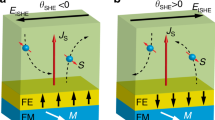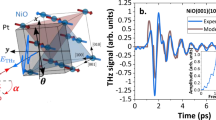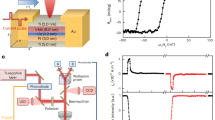Abstract
The observation of the spin Hall effect1,2,3 triggered intense research on pure spin current transport4. With the spin Hall effect1,2,5,6, the spin Seebeck effect 7,8,9 and the spin Peltier effect 10,11 already observed, our picture of pure spin current transport is almost complete. The only missing piece is the spin Nernst (–Ettingshausen) effect, which so far has been discussed only on theoretical grounds12,13,14,15. Here, we report the observation of the spin Nernst effect. By applying a longitudinal temperature gradient, we generate a pure transverse spin current in a Pt thin film. For readout, we exploit the magnetization-orientation-dependent spin transfer to an adjacent yttrium iron garnet layer, converting the spin Nernst current in Pt into a controlled change of the longitudinal and transverse thermopower voltage. Our experiments show that the spin Nernst and the spin Hall effect in Pt are of comparable magnitude, but differ in sign, as corroborated by first-principles calculations.
This is a preview of subscription content, access via your institution
Access options
Access Nature and 54 other Nature Portfolio journals
Get Nature+, our best-value online-access subscription
$29.99 / 30 days
cancel any time
Subscribe to this journal
Receive 12 print issues and online access
$259.00 per year
only $21.58 per issue
Buy this article
- Purchase on Springer Link
- Instant access to full article PDF
Prices may be subject to local taxes which are calculated during checkout



Similar content being viewed by others
References
Kato, Y. K., Myers, R. C., Gossard, A. C. & Awschalom, D. D. Observation of the spin Hall effect in semiconductors. Science 306, 1910–1913 (2004).
Wunderlich, J., Kaestner, B., Sinova, J. & Jungwirth, T. Experimental observation of the spin-Hall effect in a two-dimensional spin–orbit coupled semiconductor system. Phys. Rev. Lett. 94, 047204 (2005).
Wunderlich, J. et al. Spin Hall effect transistor. Science 330, 1801–1804 (2010).
Sinova, J., Valenzuela, S. O., Wunderlich, J., Back, C. H. & Jungwirth, T. Spin Hall effects. Rev. Mod. Phys. 87, 1213–1259 (2015).
Valenzuela, S. O. & Tinkham, M. Direct electronic measurement of the spin Hall effect. Nature 442, 176–179 (2006).
Saitoh, E., Ueda, M., Miyajima, H. & Tatara, G. Conversion of spin current into charge current at room temperature: inverse spin-Hall effect. Appl. Phys. Lett. 88, 182509 (2006).
Uchida, K. et al. Observation of the spin Seebeck effect. Nature 455, 778–781 (2008).
Jaworski, C. M. et al. Observation of the spin-Seebeck effect in a ferromagnetic semiconductor. Nat. Mater. 9, 898–903 (2010).
Uchida, K. et al. Observation of longitudinal spin-Seebeck effect in magnetic insulators. Appl. Phys. Lett. 97, 172505 (2010).
Flipse, J., Bakker, F. L., Slachter, A., Dejene, F. K. & van Wees, B. J. Direct observation of the spin-dependent Peltier effect. Nat. Nanotech. 7, 166–168 (2012).
Flipse, J. et al. Observation of the spin Peltier effect for magnetic insulators. Phys. Rev. Lett. 113, 027601 (2014).
Cheng, S., Xing, Y., Sun, Q. & Xie, X. C. Spin Nernst effect and Nernst effect in two-dimensional electron systems. Phys. Rev. B 78, 045302 (2008).
Liu, X. & Xie, X. Spin Nernst effect in the absence of a magnetic field. Solid State Commun. 150, 471–474 (2010).
Tauber, K., Gradhand, M., Fedorov, D. V. & Mertig, I. Extrinisc spin Nernst effect from first principles. Phys. Rev. Lett. 109, 026601 (2012).
Wimmer, S., Ködderitzsch, D., Chadova, K. & Ebert, H. First-principles linear response description of the spin Nernst effect. Phys. Rev. B 88, 201108 (2013).
Hall, E. On a new action of the magnet on electric currents. Am. J. Math. 2, 287–292 (1879).
Von Ettingshausen, A. & Nernst, W. Ueber das Auftreten electromotorischer Kräfte in Metallplatten, welche von einem Wärmestrome durchflossen werden und sich im magnetischen Felde befinden. Ann. Phys. 265, 343–347 (1886).
Chazalviel, J. N. & Solomon, I. Experimental evidence of the anomalous Hall effect in a nonmagnetic semiconductor. Phys. Rev. Lett. 29, 1676 (1972).
D’yakonov, M. I. & Perel’, V. I. Possibility of orienting electron spins with current. JETP Lett. 13, 467–469 (1971).
Hirsch, J. E. Spin Hall effect. Phys. Rev. Lett. 83, 1834 (1999).
Betthausen, C. et al. Spin-transistor action via tunable Landau–Zener transitions. Science 337, 324–327 (2012).
Hoffmann, A. Spin Hall effects in metals. IEEE Trans. Magn. 49, 5172–5193 (2013).
Ralph, D. C. & Stiles, M. D. Spin transfer torques. J. Magn. Magn. Mater. 320, 1190–1216 (2008).
Brataas, A., Bauer, G. E. & Kelly, P. J. Non-collinear magnetoelectronics. Phys. Rep. 427, 157–255 (2006).
Nakayama, H. et al. Spin Hall magnetoresistance induced by a nonequilibrium proximity effect. Phys. Rev. Lett. 110, 206601 (2013).
Vlietstra, N. et al. Exchange magnetic field torques in YIG/Pt bilayers observed by the spin-Hall magnetoresistance. Appl. Phys. Lett. 103, 032401 (2013).
Chen, Y.-T. et al. Theory of spin Hall magnetoresistance. Phys. Rev. B 87, 144411 (2013).
Althammer, M. et al. Quantitative study of the spin Hall magnetoresistance in ferromagnetic insulator/normal metal hybrids. Phys. Rev. B 87, 224401 (2013).
Meyer, S. et al. Temperature dependent spin transport properties of platinum inferred from spin Hall magnetoresistance measurements. Appl. Phys. Lett. 104, 242411 (2014).
Sheng, P., Sakuraba, Y., Takahashi, S., Mitani, S. & Hayashi, M. Signatures of the Spin Nernst effect in Tungsten. Preprint at http://arXiv.org/abs/1607.06594 (2016).
Acknowledgements
S.M., M.A., S.G., H.H., R.G. and S.T.B.G. thank A. Erb for the preparation of the stoichiometric YIG target, T. Brenninger for technical support, and N. Vlietstra for the non-local sample preparation. Y.-T.C. and G.E.W.B. acknowledge funding by the FOM (Stichting voor Fundamenteel Onderzoek der Materie), EU- ICT-7 ‘INSPIN’, and Grant-in-Aid for Scientific Research (Grant Nos 25247056, 25220910, 26103006). S.W. thanks S. Tölle and U. Eckern for helpful discussions. All authors acknowledge funding via the DFG Priority program 1538 ‘Spin-Caloric Transport’ (Projects GO 944/4, BA 2954/2 and EB 154/25).
Author information
Authors and Affiliations
Contributions
S.M., R.S. and T.W. designed the sample layout and carried out the experiments. S.M., Y.-T.C., G.E.W.B., R.G. and S.T.B.G. developed the explanation of the SMT effect. S.G. supervised the sample growth. Y.-T.C. and G.E.W.B. developed the theoretical framework and S.W., D.K. and H.E. performed first-principles calculations of the relevant spin-caloric transport coefficients. S.T.B.G. supervised the experiments. The manuscript was written by S.M., M.A. and S.T.B.G. All authors discussed and participated in writing the manuscript under the guidance of S.M. and G.E.W.B.
Corresponding author
Ethics declarations
Competing interests
The authors declare no competing financial interests.
Supplementary information
Supplementary Information
Supplementary Information (PDF 846 kb)
Rights and permissions
About this article
Cite this article
Meyer, S., Chen, YT., Wimmer, S. et al. Observation of the spin Nernst effect. Nature Mater 16, 977–981 (2017). https://doi.org/10.1038/nmat4964
Received:
Accepted:
Published:
Issue Date:
DOI: https://doi.org/10.1038/nmat4964
This article is cited by
-
Magnetoresistive detection of perpendicular switching in a magnetic insulator
Communications Physics (2024)
-
Chiral-phonon-activated spin Seebeck effect
Nature Materials (2023)
-
The role of spin in thermoelectricity
Nature Reviews Physics (2023)
-
Topology dependence of skyrmion Seebeck and skyrmion Nernst effect
Scientific Reports (2022)
-
Pure spin photocurrent in non-centrosymmetric crystals: bulk spin photovoltaic effect
Nature Communications (2021)



